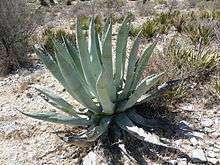Manfreda scabra
| Manfreda scabra | |
|---|---|
 | |
| Scientific classification | |
| Kingdom: | Plantae |
| Clade: | Angiosperms |
| Clade: | Monocots |
| Order: | Asparagales |
| Family: | Asparagaceae |
| Subfamily: | Agavoideae |
| Genus: | Manfreda |
| Species: | M. scabra |
| Binomial name | |
| Manfreda scabra (Ortega) McVaugh | |
| Synonyms[1] | |
| |
Manfreda scabra, also known as rough leaved agave, is a member of the Agavaceae family. [2][3]
Distribution
It is native to the Chihuahuan Desert and surrounding regions, in northeastern Mexico and Texas. [2] It grows from 500–1,500 metres (1,600–4,900 ft) in elevation. [2]
Description
Manfreda scabra is one of the larger Manfreda species, with rosettes growing 0.7–1 metre (2.3–3.3 ft) in height and 1.5–2 metres (4.9–6.6 ft) in width. [2] Though not a true Agave species, it is similar in form to many. The rosettes are suckering.
The glaucous bluish-green leaves are mostly reflexed and rough (like sand-paper). The inflorescence is up to 4.5 metres (15 ft) in height, with yellow flowers during the summer. [2]
References
- ↑ "The Plant List: A Working List of All Plant Species". Retrieved 1 October 2015.
- 1 2 3 4 5 llifle.com: Manfreda scabra
- ↑ The Complete Encyclopedia of Succulents by Zdenek Jezek and Libor Kunte.
This article is issued from
Wikipedia.
The text is licensed under Creative Commons - Attribution - Sharealike.
Additional terms may apply for the media files.